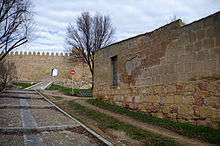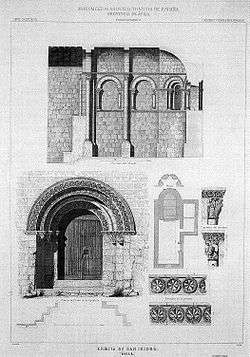Ermita de San Pelayo y San Isidoro
The Ermita de San Pelayo y San Isidoro (English: Hermitage of Saint Pelagius and Saint Isidore) was a Romanesque Catholic temple, built in the Spanish city of Ávila. It was built outside the City Walls, in front to the Gate of Malaventura in the south side of the Walls, to the west. In Ávila remains an area known as Atrium of San Isidro. After the Spanish confiscation it was moved to Madrid where had different locations. Its remains remnants finally found accommodation in the Buen Retiro Park in Madrid.[1]
History
Its first patronage was to the Córdoban child martyr, Pelagius, and thus is cited in a document of the year 1250 where says that was exempt of tax. Moreover, it known the text of consecration carved on a tombstone dated year 1270.
In honores S Marial, Deo Christi, Pelagio ipso me Petro Abulense quedámo; varones vere Christiani confirmavit, atq; consecravit Ecclessimq, reducta es Isidorum, Chalendis nobembris, Era 1270, año 1232. Et in honores divi Marial, fecit consecrare hanc Ecclesiam cuis animae Requiescat impace, Amen.
Historians who studied this tombstone assume that maybe refers to a second consecration of the church, when the dedication of Saint Pelagius is changed to Saint Isidore. After this there not come to light more documents that may inform the development and evolution of the small temple until 19th century, thanks to the book of the Cofraternity of San Isidro which was discovered in the sacristy of the church of San Nicolás in Ávila.
Also is cited that before the patronage that this hemitage had inside the Saint Isidore's saint's relics before being transferred to León in 1062.
Also are known through the documents of the Archives of Ávila, the Academy of Fine Arts and the General Archive of the Administration of Alcalá de Henares, the circumstances of its transfer to Madrid after the Spanish Confiscation.
- Confiscation and move to Madrid

atrnageIn 19th century the church belonged to the Asociación de Labradores (Association of Farm workers); it must be then when changed its patronage to Saint Isidore. Around 1854 the building was badly damaged and the City Council ordered to the Association its demolition. At the same time, the Association offered the temple to the City Council but was not accepted, so they prepared to carry out the required work of demolition. But passed a years without doing anything until in 1876 the State applied the law of Confiscation, demolishing in 1877 to sell the remains of the demolition to individuals. That was how a neighbor of Ávila bought most of the stones;[2] Emiliano Rotondo Nicolau -engineer and businessman with interests of archaeologist, resident in Madrid- bought the rest of the ashlars and architectural elements. After a failed attempt of sell to the City Hall of San Sebastian, Rotondo Nicolau could sell the ruins to the Real Academia de la Historia in 1893 for 18.000 pesetas.[3] The new location of the church was in the gardens of the Museo Arqueológico and its fate would, besides of show it as relic of the Romanesque, use as a chapel where is to give Mass with the Mozarabic Rite every Sunday.
But all just was a project until Cánovas del Castillo in 1897 it interested in the monument and the museum it ceded to City Hall of Madrid ordering its transfer to the Buen Retiro Park under the supervision and project of the architect Ricardo Velázquez Bosco.[4] The location, next to the intersection of O 'Donnell with Menéndez Pelayo, very close to the Montaña Artificial, is pleasant, surrounded by greenery and centenary trees and could have been a ruins to the romantic taste, but the building suffered another forgotten and abandoned. Finally at the beginning of 21st century City Council of Madrid sent to tidy the place recovering stones, capitals, shafts, cornices, etc. that were scattered in the environment.
Building description

The hermitage was made in rectangular ashlars of limestone. It was a temple of unique nave with wood cover. The head was semicircular with semi-dome, and straight section with barrel vault in turn divided into two parts. Both the architectural structure of the head as the decorative motifs that can be seen in the drawings of Van den Wyngaerde, Repullés and Francisco Aznar link this building with San Vicente, San Pedro and San Andrés of Ávila, so the date of construction can approach that of those temples, the mid-12th century.
In the unique nave it opened two doors, one to south and one to the west (puerta de los pies); still the remains of one of the two in which it can see the three midpoint archivolts that support in the abacuss united to impost. Although almost not noted, this impost is carved with roses of four petals inscribed in circles. The same rosettes formed the decoration carved of the archivolts; yet it can guess its trace. The capitals had a zoomorphic and vegetal decoration. Despite the deterioration it can still see the acanthus leaves.
In the apse it opened three semicircular windows with archivolt and chambrana. Remain two as witness and in its it can distinguish the deep flare ending in narrow arrowslit. The archivolts rest on abacuses and capitals that were decorated with leaves and birds with the beak between the legs, like those that can be seen in the Iglesia de San Andrés of Ávila.[5] According to the preserved drawings, in the straight section had blind arches of a single arch whose capitals were decorated with plant motifs, lions and birds. The study of this decoration has suggested in the workshops that carved San Pedro and San Vicente and the covers of San Andrés.[6]
-
Romanesque door
-
Exterior of the apse
-
Inside part of the door; at background the Casa del Pescador
-
Ruins everywhere
See also
References
- ↑ The ruins are located in Buen Retiro Park, near the confluence of avenida de Menéndez Pelayo and calle de O'Donnell. Specifically, are located in the vicinity of Montaña Artificial and Casa del Pescador, two constructions made in early-19th century within the gardens during reign of Ferdinand VII "the Felon King".
- ↑ it may see all that stones that were used to rise a wall for commercial use, in the site where was the church, in the Atrium of San Isidro.
- ↑ Merino, Alfredo (1998). "The Romanesque hermitage of San Pelayo and San Isidoro in El Retiro". Madrid, Spain: El Mundo.
- ↑ Friends of Romanesque. Retrieved April 7, 2014
- ↑ Gutiérrez Robledo 2002, p. 185.
- ↑ Vila da Vila 1999.
Coordinates: 40°25′14″N 3°40′49″W / 40.4206°N 3.6804°W